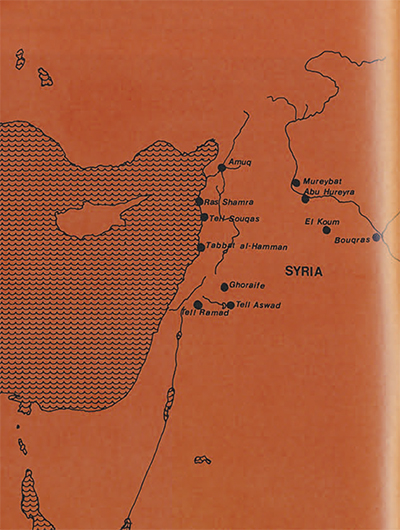
Clay is a soft and rich earthy substance consisting primarily of hydrated silicates of aluminum. It is a product of the decomposition of feldspathic rocks by erosion. The very fine particles are usually transported by water and deposited in beds with various mineral and organic impurities. Clay is plastic when wet because its small crystals are in the shape of bladelets which can slide over one another. Clay can, therefore, be modelled with the hand in an infinity of shapes. When dry, the crystals interlock and clay becomes hard until it is wetted and regains its plasticity. When fired at a temperature of 700-900°C., the crystals melt and fuse together and clay becomes irreversibly hardened.
The study of the origins of the use of clay raises three fundamental questions: When was clay first used by man? For what purposes? When was clay intentionally transformed into ceramics by fire? Answers to these questions are often elusive to archaeologists. In the Winter 1974 number of Expedition (Vol. 16, No. 2) I presented information resulting from excavations in Iraq and Iran. as well as in Anatolia. The purpose of this paper is to present the data available concerning the earliest uses of clay in Syria.
I. 150,000-10,000 B.C.: The Preliminary Stage
Latamne, Yabrud and Ksar Akil (Lebanon) are among the earliest sites in the Levant. They illustrate Paleolithic occupation from at least ca 150,000 B.C. to 10,000 B.C. The cultures identified are evidence of groups of hunters and gatherers living in seasonal or semipermanent settlements. The raw materials found in these early habitats are limited to several varieties of stone and bone. Ochre appears from Mousterian levels on. It is obvious that many more materials were used, certainly including wood, bark, skin and vegetable matter. No clay artifacts have been found in Paleolithic sites in the Near East. It may be presumed that the Paleolithic hunters were aware of the existence of clay and of its qualities of plasticity. Comparison with modern hunters and gatherers such as the Australian Aborigines would suggest that they used it, for instance, for body decoration, either as camouflage before the hunt or for religious preparations prior to such ceremonies as ritual dances or funerals. It does not seem, however, that it was used for the manufacture of any useful artifacts. Clay objects, being heavy and fragile, would not be of much use to unsettled hunters.
II. 9000-8000 B.C.: The First Phase of the Use of Clay
(1) Architecture. The earliest evidence for the use of clay in Syria appears in the Mesolithic period between 9000 and 8500 B.C. in Phase I of Tell Mureybat. Tell Mureybat is the site of a village of Natufian character which, like its Palestinian counterpart Eynan, shows some permanence of occupation. A round structure was unearthed which constitutes the earliest architecture known in Syria to utilize clay . The remains consist of a thin circular wall made of packed clay, about ten centimeters thick which is partly preserved to its original height of 50 centimeters and exhibits a flat summit. The inner face is carefully smoothed while the exterior shows parallel cylindrical grooves, possibly the imprints of the wooden poles which would have formed the superstructure.
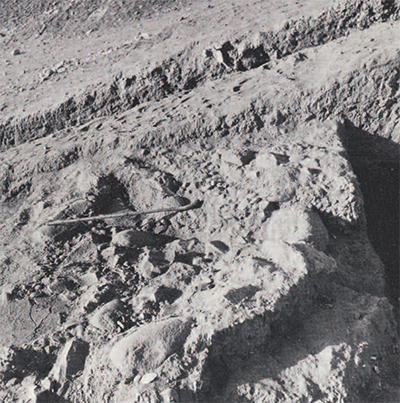
In Phase II of Tell Mureybat (8500-8000 B.C.) the site has grown to a fully sedentary village occupied by some 200 families who still rely solely for their subsistence on hunting (gazelles, onagers, wild cattle, fallow deer, boars, etc.) and gathering wild grains (wild barley, einkorn, lentils, vetches, etc.). The hunters developed a new type of round house three to four meters in diameter, sometimes made entirely of clay, but usually primarily of stone. In these stone houses, clay is still used in different fashions (Figure 1): (1) as mortar to hold the stone boulders together; (2) as a plaster on both the inside and outside of the wall; (3) for the floors, which were elaborately constructed with a layer of clay up to 20 centimeters thick, covering a foundation of flagstone or several layers of pebbles; and (4) for the roofs, which were made of bundles of reeds or twigs made waterproof by the addition of a thick layer of clay (Figure 2).
(2) House Furnishings. Inside the houses, clay may also have been used as furnishings, and in one case what seems to be a bench was built against the wall of a stone house. The feature consisted of a layer of clay covering a foundation of pebbles.
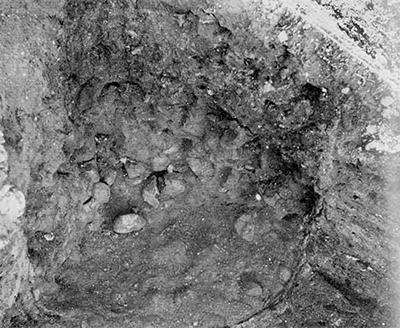
(3) Hearths. The other use of clay to report in both Phases I and II of Tell Mureybat is for hearths. They are built outside the houses and usually consist of a simple depression provided in the fresh clay floors. Although on occasion they reach the size of 1.50 meters in diameter, they are generally meant to contain a modest wood fire (Figure 3). On one occasion in Phase I, a hearth was surrounded with a semicircular clay curb. The use of clay for the building of hearths has, of course, great implications for the study of ceramics, as it illustrates the knowledge of the fact that clay is fireproof. It is also obvious that the hardening of clay by fire was not likely to escape the attention of anyone who witnessed the cold hearths.
In conclusion for this first phase, it is noteworthy that the earliest uses of clay appear together with the earliest evidences for sedentariness in life style. In the case of Tell Mureybat, sedentariness is achieved by hunters and not by farmers as usually expected. It is significant that at Tell Abu Hureyra, another Mesolithic site excavated in Syria in the vicinity of Tell Mureybat, which exhibited only a semipermanent settlement, no evidence for the use of clay was found.
While Cauvin and Moore (the excavators of Tell Mureybat and Tell Abu Hureyra) report systematic sifting of all the dirt, not a single clay object is available. The first evidence for the use of clay in Syria is, therefore, uniquely related to architecture for floors, low walls, roofs and mortar. It was possibly used for household furnishings such as seats. Because the hearths were made of clay, we may assume that the hardening process of clay by fire was noticed. It is interesting to note that as soon as clay is evidenced, three of its major qualities are utilized: plasticity, imperviousness to water, and fire resistance.
Ill. 8000.-6500 B.C.: The Transition to Neolithic
The transition between the Mesolithic and Neolithic is evidenced at three sites: Tell Mureybat (Phases III and IV), Tell Aswad (Phases I and II), and Ghoraife (Phase I). The economy still relies upon hunting and gathering at Tell. Mureybat while agriculture is practiced at Ghoraife and Tell Aswad.
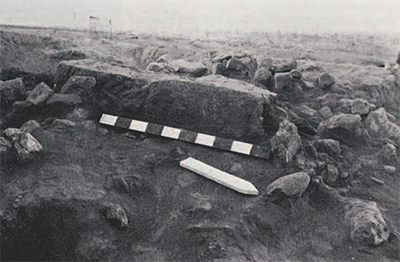
(1) Architecture. At Tell Mureybat, rectangular structures made of stone appear in addition to the former round type. They were built in the same manner as previously described, with elaborate clay floors renewed at intervals by adding a fresh layer of clay about two centimeters thick. Each new course was separated from the previous by a thin layer of sand to level the ground. It is interesting to note that the clay used in the flooring was prepared by the addition of a vegetable matter to give it more body. This process, known as tempering, later proved indispensable in controlling shrinkage of ceramics and lessening the risk of pottery cracking. It seems to have been discovered in this period without any connection with firing, and just for the purpose of reaching the right consistency. The rectangular stone houses were smeared on the inside with a thick layer of clay—sometimes as much as nine centimeters—meeting the floor at round angles. It is in this period that the plaster of a round house was found decorated with a black herringbone pattern. At Tell Aswad, plano-convex clay bricks, coarsely modeled with the hands and still bearing many finger marks and vegetable imprints, seem to have been used to build habitation platforms rather than walls. The habitats apparently consisted of huts of wattle and daub, as suggested by lumps of clay bearing traces of reeds.
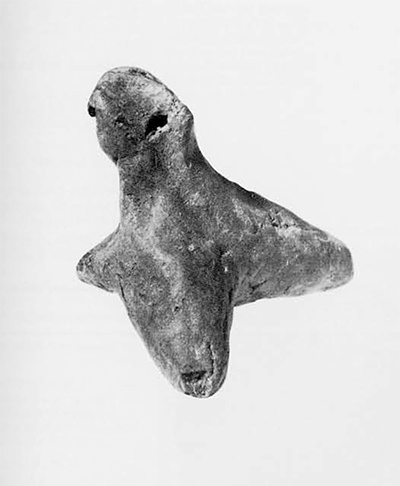
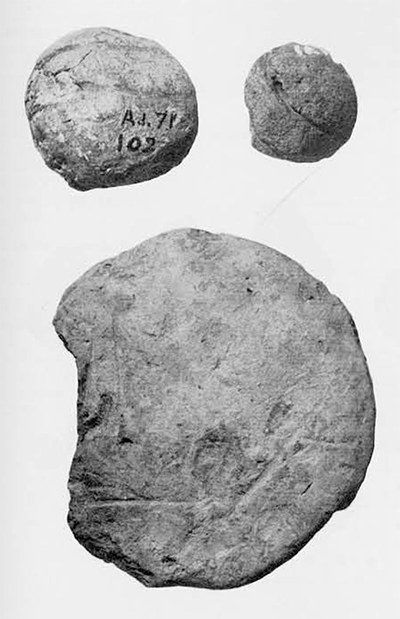
(2) Figurines. The earliest human portraitures in Syria were made of clay and are found at Tell Aswad in the shape of figurines, approximately three to six centimeters high (Figure 4). The model is a sitting female. The position was, of course, convenient as it provided a wide base for staying upright. Some of the little figures are quite elaborate, and to represent the human face it seemed important to the artist to portray a nose either by adding a long appendage or by simply pinching the clay. The eyes may be punched in with the end of a stick or applied as pellets. The hair is shown held at the back, and the only piece of garment shown is a headdress shaped like a crown or turban with a flap at the back. Mouth and ears are never represented and there is no indication that they might have been added with paint. The figures are shown with prominent breasts lying over their crossed arms. Their cigar-shaped legs, ending with little feet, are usually extended but on occasion the left leg is folded over the right one. All figurines are made of unprepared, untempered clay and do not exhibit any surface treatment. Forty animal figurines were found at Tell Aswad. Many of them are carefully modeled and can be identified as ibex, bovids and boars.
(3) Geometric Objects. Minute clay objects modeled into definite shapes such as spheres, cones, discs and cylinders, all approximately two to three centimeters in size, are found in Tell Aswad and Ghoraife (Figure 5). The small objects which I shall refer to as “geometric objects” are made of fine unprepared clay sometimes with a number of small intrusive gravels. The cones are simply modeled with the finger tips with no help of a mold; the balls, discs and cylinders were rolled between the palms of the hands. Each has, therefore, a slightly different measurement although the general shape and size are the same. The geometric objects are recurrently found in Near Eastern assemblages of the IXth to IVth millennium B.C. (see Figures 8 and 9). At Jarmo, for instance, the inventory of the 6500-6000 period records 1153 spheres, 106 cones, and 282 discs.
The geometric objects have sometimes been interpreted as game pieces (which would make Jarmo a Neolithic Monte Carlo!). Another more likely explanation is that the geometric objects were used as counting devices or calculi and that the clay cones and spheres are the prototypes of the cones and spheres punched on the earliest numerical Sumerian clay tablets to represent “1” and “10.” Three facts lead to this hypothesis.
(1) The earliest written tablets are uniquely numerical and represent records of transactions. The numbers are represented by a repertory of geometric signs, including a cone punched with the tip of a stylus and standing for “1,” and a sphere punched with the circular end of the stylus and standing for “10” (Figure 7). (2) Geometric objects were found in the archives of Susa in the IVth millennium B.C. in the same level as numerical tablets. Some geometric objects were found enclosed in hollow clay balls (called “bullae”) of the size of a fist, serving as envelopes. The variable number of geometric objects included in each bulla was interpreted by Amiet as representing records of a particular transaction—the geometric objects being calculi representing the goods exchanged.
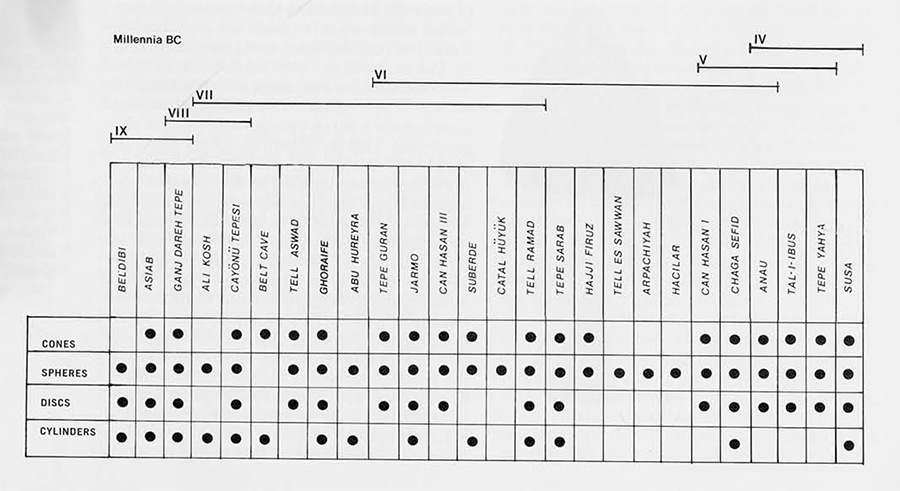
The reading of the bullae generally necessitated breaking the clay envelope to count the contained calculi; however, on a number of specimens, the number of enclosed calculi was repeated on the outside by means of punched marks of similar shapes (cones, discs, spheres, cylinders, etc.) similar to the punched numbers of the numerical tablets (Figure 7). Bullae have been excavated in a number of other Near Eastern sites, including Warka, Nineveh and Tepe Yahya (see Figure 9). (3) The geometric objects can be traced without discontinuity in assemblages from the IVth to the IXth millennium B.C. (see Figure 9). All along the millennia, their well-defined geometric shapes remain identical, attesting that they were assuming a consistent and definite function. Evidence for their firing as early as the IXth millennium suggests that their function had some importance and required permanence.
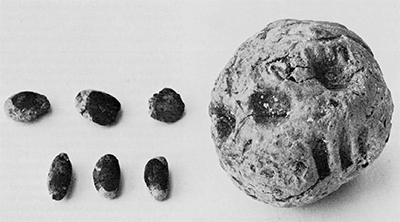
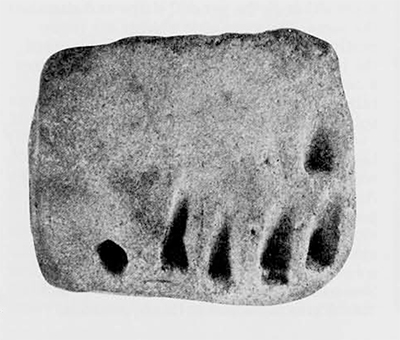
Spheres are found at Tell Aswad in a number of variations, including circular incisions following the diameter. If the small objects are, as assumed, a counting device or system of recording, their permanence by firing was advisable. No tests have yet been performed on Syrian geometric objects, but their counterparts in Iraq were analyzed by Professor W. D. Kingery, head of the division of ceramics at MIT, and were found to have been subjected to a temperature under 700°C. The black core visible in some of the broken specimens would indicate that in Syria also the calculi were fired at a low temperature which did not completely achieve total oxydization of the clay.
In conclusion for this phase, it may be underlined that contrary to the situation in the Zagros where clay objects precede solid clay architecture by 1,000 years, in Syria clay architecture precedes clay objects such as figurines and geometric objects by 1,000 years. However, this may be due to preservation of material and excavation methods and is therefore probably misleading. As the clay objects are lightly fired and represent the first ceramics, it would appear that the firing of clay artifacts occurred one millennium later in Syria than in the rest of the Middle East. The geometric objects continue throughout the next phases: they are present at Tell Ramad (Figure 10) and Tell Abu Hureyra (Figures 11, 12). Their absence in Bouqras, Koum, and Ras Shamra is only puzzling.
IV. 6500-5500 B.C.: The Uses of Clay in the Neolithic Period
Between 6500 and 6000 B.C. sites such as Tell Ramad I, Ghoraife II, Tell Abu Hureyra, Ras Shamra VC, and probably Tell Koum rely on a mixed economy with agriculture supplemented by hunting. In Bouqras I (ca 63006100), cultivation, on the contrary, seems to cease under unfavorable environment, and Bouqras II, recently redated to 6000-5500 B.C., seems to rely particularly on hunting. During this period of profound changes in the economy and way of life, the role of clay makes a tremendous advancement, becoming for instance the major building material.

(1) Architecture. In architecture, two new building techniques relying exclusively on clay are adopted: pise and mud bricks. Pis& which appears in Bouqras I, is a method of building walls by piling up layers of clay mixed with vegetable matter such as straw. When a layer (approximately 20 inches) is dry, the next can be applied until the desired height is reached. Compared to other parts of the Near East, such as the Zagros, temper is included usually sparingly in early Syria. It would be interesting to compare the various compositions of the clays of both regions and to find out whether the Syrian clays were less plastic than those of the Zagros and indeed necessitated less temper, or if this is rather a cultural habit.
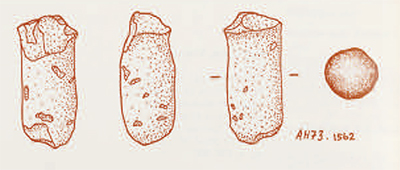
The pise houses of Bouqras are of a general rectangular shape with the walls meeting in a round curve, probably to avoid the problem of bonding. Pise is also used at Koum and Tell Ramad I, where the houses are built on an oval plan approximately three to four meters in diameter. The bricks used in the foundations at Tell Ramad were merely shaped with the hands, resulting in brown plano-convex clay balls. Vegetable imprints on the flat surface suggest that they were laid to dry on space strewn with grass. Above the foundations the superstructure was made of sun-dried rectangular clay bricks. Mud bricks may also have been used in the superstructure of the houses of Ras Shamra VC above the remaining stone foundations. In Tell Ramad and Koum, both kinds of houses—brick and pise—were sometimes finished by applying a thick mud plaster upon the walls. The roofs and floors were also made of clay. The floors of Koum were colored red with ochre and burnished. Bouqras II is characterized by mud-brick houses involving in their construction massive square pillars built with dark mud bricks, similar in texture to the pise of the previous stratum. These pillars are usually found in connection with hearths or storage basins and their use is not clear.
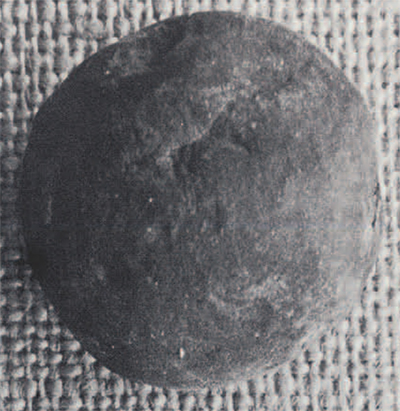
Tell Abu Hureyra is settled at this period and the small initial colony soon expands into a large village covering 11.5 hectares (28.5 acres). The mud-brick houses are clustered tightly together around courtyards and narrow lanes. The houses are facing south and southwest to catch the winter sun, a habit which has persisted in present modern villages of the area. The walls are thin, suggesting that the structures were single-storied. They are made of rectangular bricks of various sizes. The plan of the houses includes a series of rooms, as many as five in some instances (Figure 13). The various rooms were separated by partitions which could include a rectangular porthole doorway (Figure 15). The houses were faced with mud plaster, sometimes protected by a white wash. They were entered by a high sill and a mud-brick linteled doorway. Inside, the floors are plastered with much care, and their decoration includes either black painting and burnishing or black and red patterns.
(2) House Furnishings. House furnishings involving clay take the form of low platforms probably for sitting and sleeping at Tell Abu Hureyra. There are low benches installed along the walls in the entrance of one house of Bouqras II. They are made of one row of large bricks laid headlong and covered with white plaster, and are probably intended for sitting.
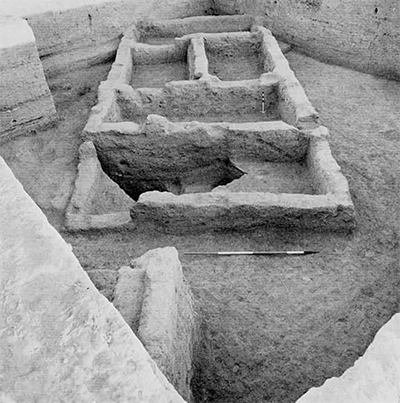
(3) Storage. Clay is an excellent material for the protection of dry food such as cereals, as it is waterproof and keeps away rodents and insects. These properties were recognized by the early farmers who had to accumulate food for the lean seasons for themselves and their herds. At Tell Abu Hureyra, plaster-lined storage bins are built inside the houses against the walls. Mesane installations appear at Tell Ramad where a silo ‘consists of a round pit, ca 1.80 meters in diameter, covered with a vaulted superstructure. At Bouqras II, food and fodder may have been stored in plain declivities of the house floors or in the large receptacles found enclosed by a curb 39 centimeters high. These are either freestanding or set between pillars.
(4) Drainage. Unique in this period is a clay pipe found in Bouqras H and made with tempered clay similar to the material used for the making of bricks. It seems to have been part of a water drainage system.
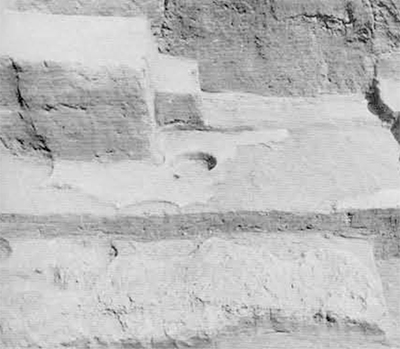
(5) Hearths and Fire Devices. Hearths at Tell Ramad and Tell Abu Hureyra continue to be basin-shaped declivities in the clay floors, placed towards the center of the rooms, They are more sophisticated in Bouqras II, where they are surrounded with a curb or a bench (Figure 14). They are situated either in the corner of a room, between two pillars, or in the center of the room. In one instance, large clay balls are found around the hearth, suggesting that they may have played a role in cooking.
Further advances in pyrotechnology are attested to at Tell Ramad with the first evidence of an oven. It is built in the shape of a small niche. As there is no indication of a chimney which would have provided a draft, the temperature reached could not have been very high.
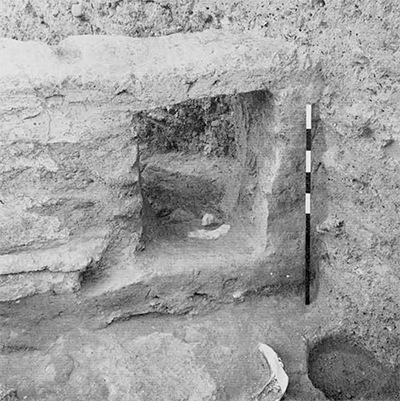
(6) Figurines. Figurines to report for this period are rare. Ras Shamra and Bouqras I each offer a single example and only rare fragments are found at Tell Abu Hureyra. Both figurines of Ras Shamra and Bouqras I are extremely schematized. The Ras Shamra example is in the shape of a rough pyramid with one curved side to represent the back, and the base is slightly excavated on one side to suggest the legs. The arms are reduced to a horizontal roll placed over the breasts. The figurine from Bouqras I is very small, measuring only 3.7 x 1.7 centimeters. It is in the shape of a mere cylinder with simple construction at the neck and at the waist and a swelling signifying arms and breasts. The figurines of Tell Ramad seem to have been somewhat more realistic. They were probably composite figures consisting of a pyriform trunk, 13 centimeters long, provided with holes at the hips to attach the legs. All these figurines were made with unprepared, untempered clay, and the firing, which has never been analyzed, is only suggested by their reddish color. The function of these figurines is not known. We have only a clue that they may have been part of a funerary ritual at Tell Ramad, where a composite figurine was found associated with six human heads whose features had been remodeled in plaster over the skull.
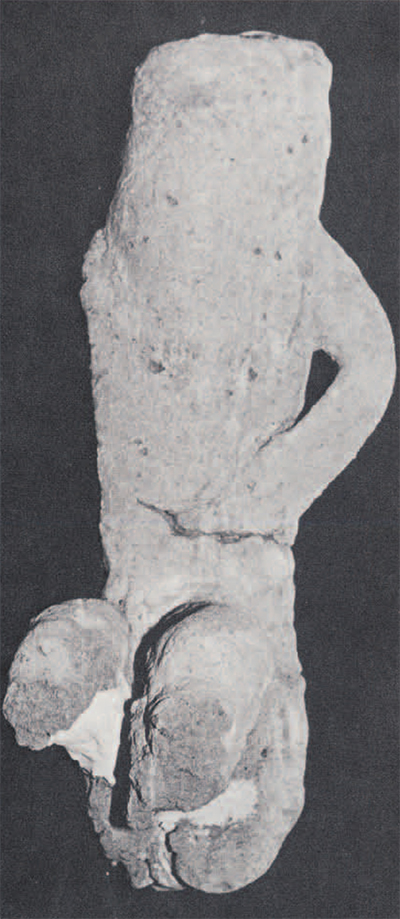
Also, two sitting figures were probably serving as stands for such skulls. Their faceless heads were reduced to a mere swelling ending in a flattened skull, The arms were placed on each side of the trunk in the shape of loop handles; the legs reached a length of 16 centimeters and the whole figures were approximately 25 centimeters in height [Figure 16). The figures were covered with a whitish wash. The pubic area was marked on one figure by a red line and on the other by a red chevron painted with ochre. Whom was this figurine embodying? Was she a protective death-goddess? A concubine for the dead? Or a slave in charge of performing all necessary domestic services for the dead in a second life?
Animals and particularly bovids and cap-rids are also represented in clay. Many have come to us broken, but the complete examples are as small as 7 x 3 x 2 centimeters. At Tell Abu Hureyra the absence of legs seems to suggest that the animal is crouching (Figure 14). Six examples are known at Tell Ramad, all quite schematized with the legs barely indicated by small rounded stumps. Their color ranges from brick red to blackish and suggests that firing was involved. Cauvin has interpreted the animal figurines as animal cult objects, which certainly would be in compliance with early Near Eastern cults; however, ethno-archaeology has also demonstrated that children in modern Near Eastern villages model such animals to play farm.
(7) Stamp Seals, Beads and Spindle Whorl. At Tell Abu Hureyra, rectangular clay plaques 5 x 2 or 5 x 2.5 centimeters, decorated on all sides with punctated and linear motifs, are interpreted as stamp seals, although the pattern would be too complicated and too confused to he really effective as a stamp (Figures 19, 20). A round clay “stamp” with a prehension knob exactly in the shape of the early stamp seals of the Halaf period bears no design at all on its face and its use is unknown (Figures 22, 23]. No seal impressions of any kind have been found at this early period, so their use is not explained.
Cylindrical clay beads were part of the personal ornaments of the villagers of Tell Abu Hureyra, together with beads and pendants of green stone and quartz (Figure 24). A new characteristic industry of the Neolithic period, namely textile weaving, is illustrated in clay by the appearance of plain clay spindle whorls at Tell Abu Hureyra (Figure 21).

In conclusion for this stage it may be underlined that the uses of clay multiply with the beginnings of domestication of plants and animals. It becomes the standard building material for human shelters, and there is an increase of house furnishings made of clay—in particular, storage facilities needed by the farmers to face the lean season. It should be mentioned that it is in this stage that a second plastic material appears which rivals clay—white plaster, probably a mixture of ground limestone with sand and water. It is used in parallel with clay for plastering house floors and hearths. Also, the skulls of the dead are modeled with this mixture to preserve their features for eternity. Some of the earliest modeled pottery containers made in Syria were made of this white plaster.
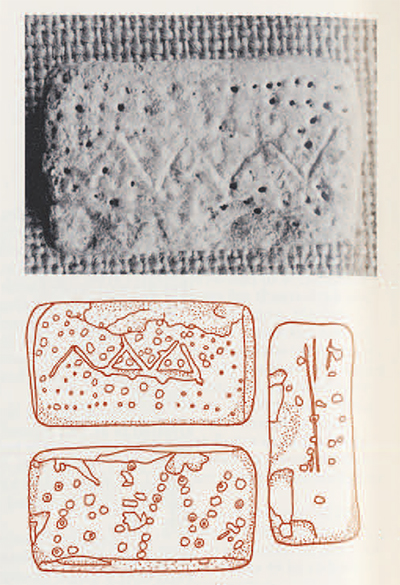
In other words, the Neolithic geometric objects are identical to those contained in bullae which were found in the archives of Susa (IVth millennium) and were identified by Pierre Amiet as counting devices or calculi. The Neolithic calculi suggest that during five millennia preceding the invention of writing, people used a three-dimensional system of recording. This is, of course, a very modest clue to the intellectual activity of the early farmers when compared to the complex markings on bones familiar in European Paleolithic sites dating ca 30,000-15,000 B.C., which have been interpreted by Alexander Marshack as lunar calendars. The calculi may have been used at this time, as they were in the IVth millennium, to keep records of transactions. Because the Sumerian pictograph for “1” was in the shape of a cone and the pictograph for “10” was a sphere, it may be suggested that the small cones stood for the unit and the spheres for “10.” The calculi express only a quantity and became meaningless when separated from their context. It might be evidence of an effort to overcome this shortcoming that spheres are found at Tell Aswad in a number of variations, including circular incisions following the diameter. If the small objects are, as assumed, a counting device or system of recording, their permanence by firing was advisable. No tests have yet been performed on Syrian geometric objects, but their counterparts in Iraq were analyzed by Professor W.d. Kingery, head of the division of ceramics at MIT, and were found to have been subjected to a temperature under 700 degrees Celsius. The black core visible in some of the broken specimens would indicate that in Syria also the calculi were fired at a low temperature which did not completely achieve total oxydization of the clay.
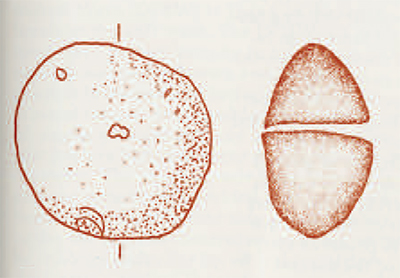
In conclusion for this phase, it may be underlined that contrary to the situation in the Zagros where clay objects precede solid clay architecture by 1,000 years, in Syria clay architecture precedes clay objects such as figurines and geometric objects by 1,000 years. However, this may be due to preservation of material and excavation methods and is therefore probably misleading. As the clay objects are lightly fired and represent the first ceramics, it would appear that the firing of clay artifacts occurred one millennium later in Syria than in the rest of the Middle East. The geometric objects continue throughout the next phases: they are present at Tell Ramad (Figure 10) and Tell Abu Hureyra (Figures 11, 12). Their absence in Bourqas, Koum, and Ras Shamra is only puzzling.
The Appearance of Pottery (Ca 6000-5500 B.C.)
The novelty of the IVth stage is the appearance of clay pottery at Tell Ramad II and III, Bouqras III, Ras Shamra VB, Amuq A, Tell Abu Hureyra, Tell Soukas 84-82 and Tabbat al Hammam. The assemblages of these sites suggest further progress in the development of agriculture, evidenced by an increase of heavier material such as large mortars and grinders. Trade between the various settlements is attested to by the presence of obsidian.
(1) Pottery. Small pottery cups appear at Tell Ramad around 6000 B.C. They are made of a very soft and crumbly buff ware which includes a mineral temper such as sand and possibly lime. The technique of manufacture is a primitive hand modeling and the cups seem to consist of a small ball of clay pinched in the center to form the walls, Their red and blackish color suggests firing. At Ras Shamra the same kind of pottery is used for more elaborate and practical shapes such as large bowls. Some of them are provided with a series of perforations directly beneath the lip, probably to secure a cover by binding. A typical jar of Ras Shamra has walls five centimeters thick and the base could reach a thickness of ten centimeters. One example was recovered to a height of 40 centimeters. This kind of pottery is also found in the “Neolithic Ancien” at Byblos.
The coarse ware described above has long been considered as the earliest pottery in Syria and was described as the first attempt of the potter’s craft in this part of the world. However, a second category of pottery of excellent quality called the Dark Faced Burnished Ware (DFBW) is found in the same levels as the soft ware. The DFBW is a well-fired, hard pottery ranging in color from buff-reddish and red to brown and black. The paste is brownish and includes a very fine mineral temper. It is used for the manufacture of simple globular jars and bowls six to ten centimeters high and about 15 centimeters in diameter. The small vessels have thin walls and are sometimes provided with small prehension knobs on either side, often directly under the lip. The decoration includes pattern burnishing under the lip with shiny strips contrasting against the remaining mat surface of the vessel, short incised strokes in horizontal line, comb vertical or zigzag pattern. The sudden intrusion of the DFBW at Ras Shamra had led C. Schaeffer to believe in a movement of population in the area, an idea which has little appeal today. In Tell Ramad the DFBW also appears immediately in substantial quantity, but this is not the case everywhere, For instance, in Bouqras only 16 sherds were found in the first pottery level. The DFBW is common in all Neolithic pottery sites of Turkey and is believed by Bostanci to appear as early as 8500 B.C. at Beldibi. As the obsidian trade illustrates an extensive relation of the Neolithic Syrian sites with Turkey, the DFBW may be part of the ideas exchanged along the trade routes. The quality, temper and firing process differ slightly from site to site, suggesting that the vessels are made locally and were not imported from a specific center. The use of DFBW challenges the white plaster vessels, which totally disappear at Tell Ramad.
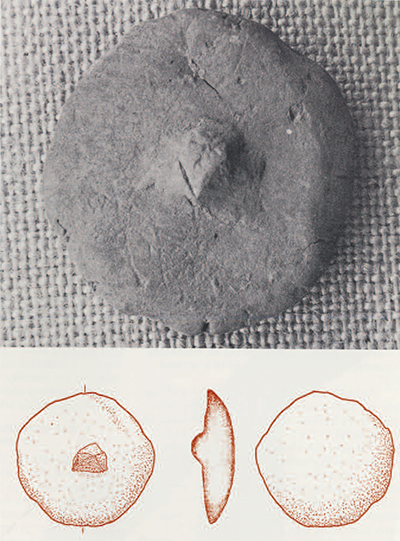
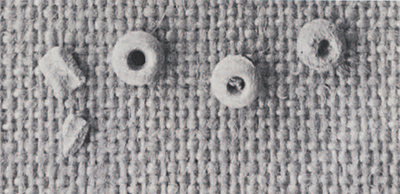
[2) Architecture. Noticeable changes occur in the architecture of Ramad II. The houses change shape from oval to rectilinear buildings consisting of a single spacious room which could measure as much as 7 meters in length. Pise and bun-shaped bricks remain in use, but a new type of standard measure clay bricks appears. They are of yellow color and measure around 40 x 30 x 8 centimeters, indicating the use of a wooden mold for their manufacture. The brick walls are built on a stone foundation and are held together with a greyish mortar prepared with little straw temper. Clay is also used in thick layers to plaster walls and floors. Bricks are also the typical building material of Bouqras III and Tell Abu Hureyra Pottery Neolithic.
(3) Figurines. Figurines are abundant in this phase but unfortunately are often found in a poor state of preservation and seem to disintegrate in the soil or in the hands of the excavators. Several types are represented, the first showing human representations with discoid heads and pellet eyes; a second category has long cylindrical faces with pinched nose and pellet eyes and ends with a high conical headdress (Figure 25). A more naturalistic type seems also to have been represented, judging from fragments of trunk and rather realistic legs, but no specimen has come to us complete. The blackish color of all figurines suggests that firing was used in their manufacture.
Two dozen animal figurines were found at Tell Ramad while a single example is recorded for Bouqras. Although their paste is hard and their blackish color suggests firing, most of the animal figurines are fragmentary and consist of heads without bodies, bodies without heads, and separate horns. We may presume that mostly caprids or cattle were represented, but dogs and possibly equids are also present. All species are represented standing in the same position with sometimes the neck outstretched. All are very schematic and the bodies are reduced to a long cylinder with four stumpy legs; the tail is one detail which is sometimes added. There is no surface treatment.
(4) Stamp Seals. Two clay stamp seals were uncovered at Ras Shamra VB. The first is round shaped and was provided with a suspension ring. The second is oval and is topped with a thick knob pierced for suspension. Both have a plain linear motif. No sealings have been identified in this level and the “seals” may in fact have served to imprint a pattern on textiles or for body paint.
In conclusion it may be of interest to compare the earliest evidences of the uses of clay in Syria with those of other regions of the Middle East such as the Zagros and Anatolia.
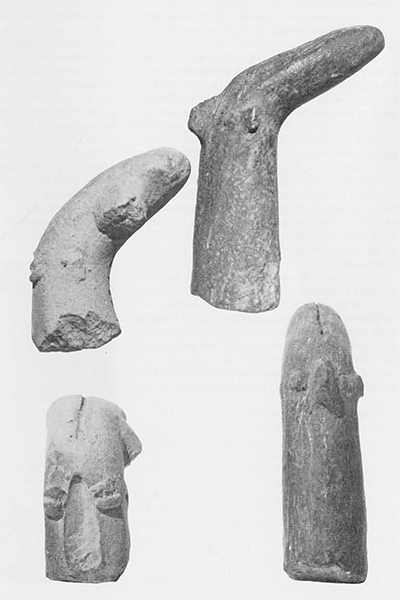
The date 9000-8500 B.C. for the beginnings of the use of clay is consistent in all three areas: Tepe Asiab and Beldibi, which yield the earliest clay artifacts respectively in the Zagros and in Anatolia belong to the same range of time as Tell Mureybat. The evolution of the use of clay seems also consistently related to the earliest attempt at sedentariness. As the security of a tribe on the move from one camp to another relies on its mobility, nomadic hunters reduce their belongings to a bare minimum of light-weight necessary utensils. It is obvious that as soon as they are settled, people can and do multiply their possessions and accumulate goods. Heaviness and fragility of materials cease also to be an important consideration for personal belongings. This allows for the adoption of a wider range of raw materials, including clay and, for instance, soft stone easy to carve. It is also a consistent feature that the uses of clay are related to the progress of agriculture and reach the first climax in fully developed farming communities such as Tell Rained, Catal Huyuk and Jarmo in the VIIth millennium.
The only point on which Syria seems not to follow the general Near Eastern trend is the sequence of the development of the uses of clay. In the Zagros small objects such as geometric objects, beads and minute figurines appear first around 8500 B.C. and elaborate clay architecture follows one millennium later. The reverse is true in Syria where clay architecture appears first and is followed one millennium later by modeled clay objects. This, of course, raises the question of whether we are dealing with a cultural difference or simply a difference in the archaeological fill, sandy in the Zagros where clay objects can be separated easily, and hard and compact in Syria where they may escape the archaeologist’s vigilance.
